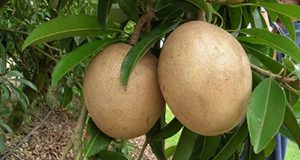Abstract
This 6-page fact sheet written by Edward A. Evans, Fredy H. Ballen, Aditya Singh, and Jonathan H. Crane and published by the UF/IFAS Food and Resource Economics Department provides an estimate of the costs and returns associated with an established sapodilla orchard in south Florida. The information presented is based on a wide range of production practices collected through field interviews with growers and industry specialists and is intended as a guide to estimate the financial aspects of operating an established sapodilla grove. Please note that sapodilla has been assessed by the UF/IFAS Invasive Plants Working Group as potentially invasive in south and central Florida. It should not be planted in home landscapes or in groves near natural areas. Sapodilla plantings must be fenced, and the fruit must be moved in covered vehicles to prevent fruit being eaten by wildlife and the plant from infesting areas outside the grove.
http://edis.ifas.ufl.edu/fe1015
References
Campbell, R.J., and N. Ledesma. 2002. "The sapodilla and green sapote's potential in tropical America." Proceedings of the InterAmerican Society of Tropical Horticulture 46: 55-56.
Campbell, R.J., G. Zill, and H. Mahdeem. 1997. "New sapodilla cultivars with commercial potential." Proceedings of the InterAmerican Society of Tropical Horticulture 41: 215-218.
Coronel, R.E. 1991. Manilkara zapota (l.) P. van Royen. In Plant Resources of South-East Asia, No. 2: Edible Fruits and Nuts, edited by E.W.M. Verheij and R.E. Coronel, pp. 220-223. Wageningen, Netherlands: Pudo-DLO.
Crane, J.H., C.F. Balerdi, and I. Maguire. 2016. Sapodilla Growing in the Florida Home Landscape. HS1. Gainesville: University of Florida Institute of Food and Agricultural Sciences. https://edis.ifas.ufl.edu/pdffiles/MG/MG05700.pdf
Crane, J.H., and A.M. Mossler. 2013. Florida Crop / Pest Management Profile: Mamey Sapote and Sapodilla. ECIR1414. Gainesville: University of Florida Institute of Food and Agricultural Sciences. http://edis.ifas.ufl.edu/pdffiles/PI/PI05400.pdf.
IBPGR 1986. Sapodilla. Genetic Resources of Tropical and Sub-tropical Fruits and Nuts. Rome: IBPRG (International Board for Plant Genetics Research). http://pdf.usaid.gov/pdf_docs/PNAAW619.pdf.
Ledesma, N. 2013. Sapodilla (Chiku) as a Delicate Dessert. Coral Gables, FL: Fairchild Tropical Botanic Garden. http://www.fairchildgarden.org/news-pressroom-media-center/articles/artmid/515/articleid/973.
Martinez, J.I., J.E. Hayden, J.B. Heppner, J.E. Pena, L. Xiao, and D. Carrillo. 2017. "Banisia argutula (Lepidoptera: Thyrididae) is the dominant Sapodilla borer in southern Florida." Florida Entomologist 100(1): 57-62. http://www.bioone.org/doi/abs/10.1653/024.100.0110. https://doi.org/10.1653/024.100.0110
UF/IFAS. 2017. Assessment of Non-Native Plants in Florida's Natural Areas. Gainesville: University of Florida Institute of Food and Agricultural Sciences. http://assessment.ifas.ufl.edu/.
Unless otherwise specified, articles published in the EDIS journal after January 1, 2024 are licensed under a Creative Commons Attribution-NonCommercial-NoDerivs 4.0 International (CC BY-NC-ND 4.0) license.

